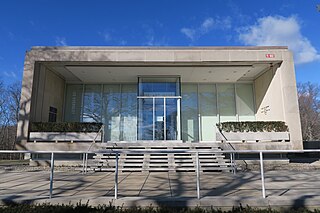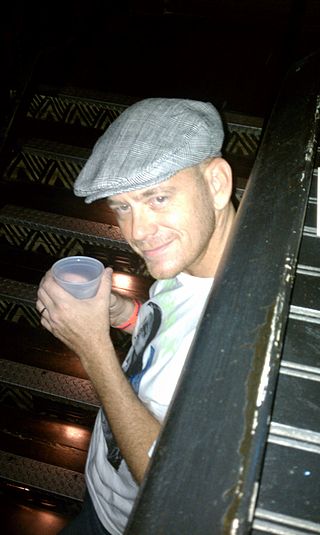Related Research Articles

The San Francisco Museum of Modern Art (SFMOMA) is a modern and contemporary art museum located in San Francisco, California. A nonprofit organization, SFMOMA holds an internationally recognized collection of modern and contemporary art, and was the first museum on the West Coast devoted solely to 20th-century art. The museum's current collection includes over 33,000 works of painting, sculpture, photography, architecture, design, and media arts, and moving into the 21st century. The collection is displayed in 170,000 square feet (16,000 m2) of exhibition space, making the museum one of the largest in the United States overall, and one of the largest in the world for modern and contemporary art.

The Ashcan School, also called the Ash Can School, was an artistic movement in the United States during the late 19th-early 20th century that produced works portraying scenes of daily life in New York, often in the city's poorer neighborhoods.

John Kirk Train Varnedoe was an American art historian, the chief curator of painting and sculpture at the Museum of Modern Art (MoMA) from 1988 to 2001, Professor of the History of Art at the Institute for Advanced Study in Princeton, New Jersey, and Professor of Fine Arts at the New York University Institute of Fine Arts.
Henry Geldzahler was a Belgian-born American curator of contemporary art in the late 20th century, as well as a historian and critic of modern art. He is best known for his work at the Metropolitan Museum of Art and as New York City Commissioner of Cultural Affairs, and for his social role in the art world with a close relationship with contemporary artists.

Karl Gunnar Vougt Pontus Hultén was a Swedish art collector and museum director. Pontus Hultén is regarded as one of the most distinguished museum professionals of the twentieth century. He was the pioneering former head of the Museum of Modern Art in Stockholm and in the 1970s he was invited to participate in the creation of the Centre Georges Pompidou in Paris, where he was the first director of the Musée National d'Art Moderne (MNAM) in 1974–1981.

The Rose Art Museum, founded in 1961, is a part of Brandeis University in Waltham, Massachusetts, US. Named after benefactors Edward and Bertha Rose, it offers temporary exhibitions, and it displays and houses works of art from the permanent collection of 9,000 objects. The museum has one of the largest collections of modern and contemporary art in New England. Since its inauguration, the Rose Art Museum has been recognized for its avant-garde and forward-thinking approach to modern and contemporary art.
Robert Rosenblum was an American art historian and curator known for his influential and often irreverent scholarship on European and American art of the mid-eighteenth to 20th centuries.

Beatriz Colomina is an architecture historian, theorist and curator. She is the founding director of the Program in Media and Modernity at Princeton University, the Howard Crosby Butler Professor of the History of Architecture and director of graduate studies in the School of Architecture.

Stephen Baron Johnsonis an American artist. He is most well known for linear style, influenced by architecture and other objects relating to the built environment.
William Stanley Rubin was an American art scholar, a distinguished curator, critic, collector, art historian and teacher of modern art.

Autumn Rhythm is a 1950 abstract expressionist painting by American artist Jackson Pollock in the collection of the Metropolitan Museum of Art in New York City. The work is a distinguished example of Pollock's 1947-52 poured-painting style, and is often considered one of his most notable works.
Peter Curtis Bunnell was an American author, scholar and historian of photography. For more than 40 years he had a significant impact on collecting, exhibiting, teaching and practicing photography through his work as a university professor, museum curator and prolific author.
Maurice Tuchman is an American curator. He worked as the first curator of twentieth century art at Los Angeles County Museum of Art (LACMA), where he organized several notable exhibitions.
Peter Howard Selz was a German-born American art historian and museum director and curator who specialized in German Expressionism.

Paul Hayes Tucker is an American art historian, professor, curator, and author. His specialties include Claude Monet and impressionism.
Emily Braun is a Canadian-born art historian, curator and distinguished professor of art history at Hunter College and the Graduate Center of the City University of New York. Braun is a specialist in the history of modern European art and is known for her contributions to the study of Italian modernism and cubism. In addition to her academic work, Braun serves as the curator of the Leonard A. Lauder Collection of Cubist Art.
Stanton Loomis Catlin was an American art historian, specializing in Latin America. After studying at Oberlin College and the Academy of Fine Arts, Prague, he was to have studied European modern art. The Second World War interrupted these plans and he instead focused on Latin American art. During the war Catlin assisted with exhibiting American art in Latin America, served as a Latin American specialist with the Office of the Coordinator of Inter-American Affairs and as a lecturer at the University of Chile. At the war's end he served with the United Nations Relief and Rehabilitation Administration in Germany, assisting displaced persons.
Michael P. Mezzatesta is an American art historian, curator, and museum director. He served as the Mary D.B.T. and James H. Semans Director of the Nasher Museum of Art at Duke University from 1987 to 2003.
Francis Valentine O’Connor was an American art historian who was pioneering scholar of the visual art of the New Deal and an expert on the contemporary artist Jackson Pollock.
References
- ↑ Hunter, Sam Archived 2013-10-29 at the Wayback Machine , Dictionary of Art Historians. Accessed 9 June 2013.
- 1 2 Sam Hunter, Rose Art Museum's first director, dies, Brandeis University. Accessed March 7, 2020.
- ↑ Smith, Roberta (2014-08-25). "Sam Hunter, Curator and Museum Founder, Dies at 91". The New York Times. ISSN 0362-4331 . Retrieved 2016-04-09.
- ↑ Davies, Sally Yard, Hugh M. "Sally Yard and Hugh M. Davies on Sam Hunter (1923–2014)". artforum.com. Retrieved 2016-04-09.
{{cite web}}: CS1 maint: multiple names: authors list (link) - ↑ "Princeton University - Samuel Hunter, authority on 20th-century art and 'profound' mentor, dies". www.princeton.edu. Archived from the original on 2017-05-04. Retrieved 2016-04-09.
{{cite web}}: CS1 maint: bot: original URL status unknown (link)